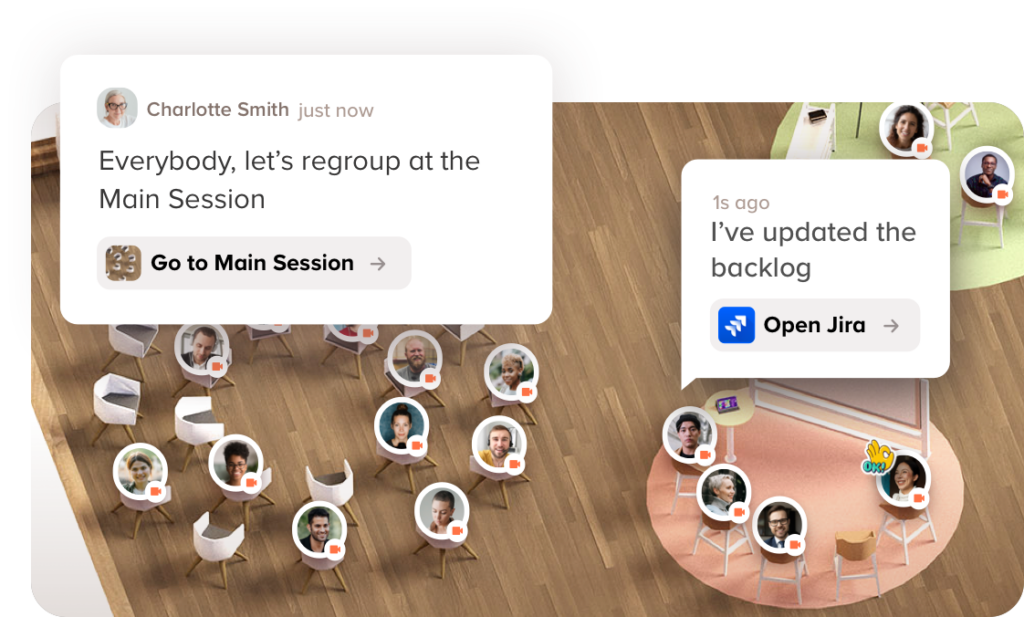
Challenge
How can you bring the positive aspects of in-person collaboration to a distributed team?
Triggered by the Covid pandemic, we are in the midst of arguably the biggest workplace shift in 100 years: moving from predominantly in-person work to a complex mix of distributed, remote, and hybrid work. This ‘new normal’ model impacts all organizations and necessitates that teams employing SAFe® and other forms of scaling agile become adept at distributed planning. In this post, we’ll explore how visual collaboration spaces from Welo can improve the most important planning ceremony.
89%
of agile teams are distributed
PI Planning was originally conceived by SAFe® as a two-day face-to-face event to align agile teams on the Agile Release Train (ART) around the key features to be delivered in the forthcoming PI and enable them to develop the necessary Iteration plans. To keep teams moving forward amid Covid restrictions, companies nimbly put existing tools to work:
- Video conferencing platforms such as Zoom, Microsoft Teams, Google Meet, and Webex
- Messaging apps such as Slack, Microsoft Teams, and Google Chat
- Project management software such as Jira, Confluence, and Easy Agile
- Online whiteboards such as Miro, Mural, Appfire, and LucidChart
These tools continue to support the permanent switch to remote work: the 15th State of Agile Report reports that 89% of agile teams continue to perform some of their work as a distributed team. The reasons for the transition are varied, including operational costs savings for employers, flexibility in scheduling meetings, and reduced stress among employees who prefer to have the option to work from home.
Unfortunately, the benefits of distributed work come with a cost. Remote workers:
- Lack spontaneous, location-based conversations, which can cause isolation and a sense of disconnect from teammates and company strategy
- Often schedule too many back-to-back meetings, creating burn-out
- Feel marginalized when they’re forced in and out of pre-planned breakout rooms
- Drift into silos because they can’t easily connect with other teams
Providing distributed teams with the practical and human aspects of an in-person PI Planning experience is a challenge. The current toolset isn’t sufficient to ensure that teams thrive. In fact, it is rife with inefficiencies and frustration for all involved, including:
- Limited opportunities for in-the-moment individual conversations inhibit camaraderie, personal connections, and company loyalty
- Sharing documents via chat has team members struggling to find the resources they need
- Shuffling people around in their static boxes from plenary sessions to break-out rooms lacks agency, making team members feel disempowered
- Sending and receiving multiple calendar invites and Zoom or Teams links in an attempt to have people keep track of where they need to be when
Opportunity
Foster shared understanding, empathy & experience among distributed teams in virtual collaboration spaces
When a physical space no longer serves as the hub for shared context and experiences, agile teams need to work within a visually-oriented virtual space designed to promote understanding, empathy, and shared experience.
Shared understanding
Clarity of vision, mission, and purpose–as well as visibility into what team members are doing–facilitating learning loops among colleagues.
Shared empathy
Forging human connections with colleagues creates the psychological safety to learn, grow, and iterate.
Shared experience
Creating a sense of team place and identity, of building together.
Success Criteria
Facilitate full engagement in PI Planning
The good news is that companies are now able to integrate visual collaboration spaces into their existing video conferencing and communication platforms to elicit full employee engagement in distributed PI Planning.

Welo visual collaboration spaces power the following attributes, critical to generating the successful PI outcomes realized when teams gathered as a group:
A visual & visible experience:
Recreating a sense of team place and identity, emulating the feel and flow of working with colleagues in a physical space ensures people are heard, seen, and can easily engage.
- Professionally-designed spaces for large and small groups as needed–beyond the static squares of standard videoconferencing.
- Plenary rooms for full team event briefings, break-out rooms where teams create their iteration plans, private rooms to support negotiations on scope and priority, and shared spaces where key agreements, such as PI Objectives, are always accessible.
Effortless ad-hoc collaboration:
The kind that builds bonds among colleagues and a company culture that nurtures trust, camaraderie, and wellbeing does not happen in formally-scheduled time slots. It happens dynamically and must be facilitated online.
Fluid movement & interactions:
Maximizing effectiveness of work groups.
- Rather than feel confined to a static rectangle, agile team members see themselves and others in context.
- Team members move seamlessly with agency between rooms to connect with colleagues before, during, and between PI Planning activities.
Situational awareness:
High-impact PI Planning requires business stakeholders, product owners, and other leaders to be visible and approachable.
- Easy to see if colleagues are engaged, available to meet, free for a quick question, or looking to relax and socialize with others.
Access to relevant information in context:
Trusted PI Planning tools embedded in the virtual places employees congregate–eliminating the need to bounce among different applications and windows.
- In-room resource links for team members to have ready access to up-to-date resources such as Jira and Easy Agile apps–in context, in the moment to keep pace.
- Real-time transcription provided.
- Tools integrated into enterprise platforms.
Real-time communications & collaboration:
Radiating key information to team members from all relevant sources.
- Speeds progress of work and human connections.
- No more living life in half-hour chunks.
- Eliminates meeting and email overload.
Looking ahead
Fueling high-performance, employee satisfaction & organizational success
We are at an exciting crossroads for companies to choose how and where work gets done. The time is now to bring the best of in-person and virtual experiences to distributed teams to help fuel high-performance, employee satisfaction, and organizational success.
Welo levels up the human experience for a distributed team at Mercer
The Mercer Employee Research and Engagement Group measured the impact of Welo on team effectiveness and reported enhanced efficiency, collaboration, and support from colleagues and management. Employees reported an almost 30% increase in their perception of team efficiency, an almost 40% increase in collaboration, and 22% increase in connection with colleagues and coworkers.
“As online work becomes a bigger part of our lives, it is crucial to give people the flexibility they need to make video meetings efficient and meaningful,” said Cliff Pollan, Welo’s co-founder and CEO. “Our mission is to improve productivity and revive culture in the distributed work paradigm and we are thrilled that our solution delivered.”
About Welo
Welo visual collaboration spaces power the experience of working together when physically apart–so distributed and hybrid teams feel part of a community with shared purpose. We facilitate online the planned, fluid, and social interactions that occur naturally in physical spaces.
WIth Welo’s visual orientation beyond the isolated video box, people are present in the context of a space designed for a specific reason–and empowered to move around naturally to interact with others as they did in physical spaces–maximizing employee effectiveness, creativity, and commitment.
Developed with industry-leading partners, Zoom and Atlassian, WELO is currently used in more than 100 countries.
Welo for Zoom and Welo available today.


